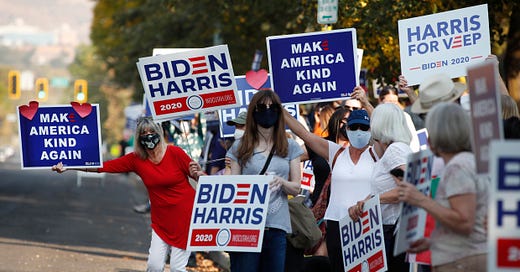

CONSERVATIVE AND MAINSTREAM MEDIA don’t agree on much, but one point of consensus is that everyone should work harder to understand Trump supporters. The implicit message: You don’t have to agree with the populist right, but you should be listening to, empathizing with, and engaging them more.
A common style of this coverage is the safari to “Trump Country,” in which journalists from various outlets, most of whom live in big metropolitan areas, go to a rural community or Rust Belt town and talk to Trump voters, often white, working-class men in diners. The resulting articles are often tautological—basically “Trump Supporters Support Trump”—and framed as if explaining to liberals who might think that Trump’s failures will cause some voters to abandon him that they won’t. A great example is a May 2019 New York Times story titled “There’s No Boom in Youngstown, but Blue-Collar Workers Are Sticking With Trump.” It’s such a well-trod trope that it’s inspired parodies and running jokes.
Going beyond those attempts to understand Trump voters are two recent arguments that got attention on social media.
First, in his New York Times column early this month, David Brooks argued that “elites” have been “behaving in ways that make Trumpism inevitable.” In particular, Brooks writes, “it’s easy to understand why people in less-educated classes would conclude that they are under economic, political, cultural and moral assault—and why they’ve rallied around Trump as their best warrior against the educated class.” Brooks encouraged his readers to imagine what the last half-century of American history looks like from the vantage of those non-elites.
Second, “Slow Boring” writer Matt Yglesias defended himself against criticism that he recommended articles by Richard Hanania, a rising star on the right who used to make explicitly white supremacist arguments under a pseudonym (and who’s been nearly as explicit under his real name, too). “He’s clearly quite racist,” Yglesias conceded, “but I also think he’s written some good pieces and it’s important to read conservatives.”
Seeing these arguments, I was struck by the asymmetry of our political moment: I’ve never seen centrists like Yglesias say to people on the right (or center) that it’s important to read progressives (even if they’re super woke, or whatever the left-wing equivalent of Hanania’s racism is). Nor have I seen traditional conservatives like Brooks call for empathy with people on the left, or claim that any left-wing extremism is merely an inevitable reaction to centrist and conservative elites’ mistakes.
Reporters don’t do safaris to “Biden Country,” seeking to understand the voters who put him in the White House. While there are pieces explaining how, for example, black women in Georgia suburbs made a big difference in the 2020 election, there’s nothing approaching the ongoing coverage of white men in Ohio diners.
In case I had a blind spot, I turned to crowdsourcing, asking on social media whether anyone knew of examples of journalists making the case for trying to understand the Biden voter. Few could think of any. The two closest were a September 2019 National Review article by Jim Geraghty called “Inside the Mind of the Biden Voter” and recent podcast interviews by former GOP Rep. Joe Walsh, such as with Charlotte Clymer, a trans woman who’s worked for LGBT rights and pro-choice advocacy groups.
If anything, those exceptions prove the rule. Walsh does implore conservatives to reach across political and cultural divides, but hasn’t held office since 2013, and angered Republicans by launching a primary challenge to Trump in 2019, leaving the party in early 2020 after it flopped.
Meanwhile, the Geraghty piece is four years old, and about the 2020 primary. It argues, without citing a single Democratic voter or data point, that older Democrats preferred Biden over more left-wing rivals because they didn’t mind his age, liked him as vice president, and thought he was the safest choice to take on Trump.
Four years later, discussing “what keeps Democrats up at night” heading into 2024, Geraghty asserts that “Democrats perceive themselves to be more popular than they are and American society to be much more unified behind their agenda and worldview than it is.” Among his evidence: “Oscar-bait movies . . . depicting some heroic multiracial gay handicapped abortionist who wants to save the rainforests” and the right-wing backlash to Bud Light doing a niche promotion with trans internet personality Dylan Mulvaney. Regarding the president’s campaign for re-election, Geraghty argues that a big reason Democrats are nervous is because, as National Review editor Charles C.W. Cooke put it, “Joe Biden is an asshole” and “always has been.”
Anyone’s entitled to their opinion of the president, but it’s safe to say most Democrats don’t share that one. Even in a piece purportedly about what Democrats are thinking, Geraghty focused on how he thinks Democrats misunderstand Republicans and independents, rather than trying to help Republicans understand how Democrats see themselves, let alone imploring conservatives to show more respect and sympathy towards liberals’ point of view, even if they disagree with it.
Anti-Trump and Conventional Wisdom
Let’s return for a moment to David Brooks’s argument. Brooks gets some big things wrong, but since so many other writers have already picked apart his column—see, for instance, articles here in The Bulwark by Mona Charen and Cathy Young, and elsewhere by Zack Beauchamp and Daniel Drezner—I’ll start with where he’s on the right track. By and large, he’s not wrong to say that “anti-Trumpers” are dumbfounded by the Trump phenomenon, incredulously asking “Why is this guy still politically viable, after all he’s done?” They might have an answer, but even if they think they’ve grasped it intellectually, anti-Trumpers have trouble relating to it. They don’t just hold different opinions; they base political opinions on different things.
That’s one major explanation for the Rust Belt diner safaris, and the calls for more efforts to empathize. Many journalists, editors, and political analysts at mainstream outlets headquartered in New York or Washington, D.C. were surprised by the rise of Trump and his 2016 win. Sensitive to accusations that they have a liberal and/or pro-establishment bias, and believing that his rise could represent a political shift worth studying, they bend over backwards to try to understand the mind of the Trump voter.
But here’s the thing: Many journalists, editors, and political analysts were also surprised by Biden’s strong win in the 2020 primaries after he lost the first two contests in Iowa and New Hampshire. His nomination defied the narrative that the Democratic party had lurched to the left, becoming obsessed with identity politics and eager for socialism.
Even more surprise followed the 2022 midterms: Recall that Republican politicians, conservative writers (including Jim Geraghty), centrist pundits, and even mainstream news articles treated a “red wave” as all but inevitable, with some so confident that they upgraded it to a “tsunami.” Instead, Democrats defied historical patterns, a mediocre economy, and a relatively low presidential approval rating to keep the House close, gain a seat in the Senate, and make state governments bluer. It was the best midterm election for a president’s party since George W. Bush a year after 9/11.
Apparently, many who purport to know about politics need to work harder at listening to, understanding, and empathizing with Biden voters.
The Biden Coalition
Over 81 million Americans voted for Joe Biden, and the vast majority sure aren’t societal elites. They struggle with rising costs—of housing, healthcare, groceries, college, etc.—and economic disruptions from globalization and technological change. They might be hurt more by the decline of shopping malls than the decline of coal mining, but both impose economic difficulties on the larger community.
By every reasonable definition of working and middle class, the Biden coalition has tons of them.
By income: Biden won by about 10 percentage points among voters whose families made less than $50,000 per year.1 The data are less clear regarding voters whose families made between $50,000 and $100,000—one major survey showed these voters went for Biden by 15 percentage points, while another showed them evenly divided among Biden and Trump, 49–49—but no data show Trump decisively winning this group, as he did voters with incomes over $100,000.
By education level: As the Washington Post’s Greg Sargent points out, drawing on data from Pew, a majority of Biden voters (53 percent) didn’t have a college degree. That’s a more balanced coalition than Trump’s (70 percent non-college-educated), but the difference is overwhelmingly explained by race. Biden cleaned up among voters of color without a college degree (72–26), doing slightly better than his victory among non-white college graduates (70–27). Among white voters, Biden narrowly won college grads (51–48), and got crushed among non-college (32–67).
It’s worth remembering that when commentators (such as David Brooks) talk about highly educated elites creating social structures that perpetuate their class at the expense of everyone else, most college grads don’t see themselves fitting that description. Some 38 percent of Americans over the age of 25 have a bachelor’s degree or higher, and way more went to big public universities than top-ranked private schools. Many of them graduated into bad job markets, and even some who got jobs they wanted have trouble paying student loans.
And remember too that they see a lot of conservative Ivy League grads among America’s actual elite. Five GOP-nominated Supreme Court Justices went to Harvard or Yale, Ron DeSantis has degrees from Harvard and Yale, Trump graduated from Wharton business school at UPenn.
By type of work: If we want to think about populism in terms of kind of work that people do—in terms, say, of people whose jobs have them working on their feet and with their hands vs. working at a desk on a computer—while the percentage of “blue-collar” workers who vote Republican has risen in recent elections, there are still tens of millions of Biden voters who work in manufacturing, the trades, food service, hospitality, nursing, elder care, teaching, retail, and more. They often find work physically draining, and couldn’t work from home during COVID. Some of the people in those jobs have college degrees, of course, but that doesn’t mean they’re rich or influential.
By location: A popular Rust Belt diner safari destination, Ohio’s Mahoning County, which contains Youngstown, actually had fairly close elections in both 2016 (Trump won it 50–46) and 2020 (Trump won it 50–48). The reporters who traveled there hoping to decode Trump voters could make the same trip wondering about the resilience of Democrats and asking what makes Biden voters tick.
And don’t forget that there are more working-class Americans in, say, Queens, New York than in entire red states. Treating elite and lives in a major metropolitan area as interchangeable synonyms is absurd.
The only definition of “elites” that includes most Biden voters is the postmodern one popular with today’s right-wing culture warriors: “disagrees with me on social issues.” But virtually no one outside the culture-war right thinks a millionaire who owns car dealerships but didn’t go to college, or a tech-industry venture capitalist who complains about the “woke mob,” are working class, while a middle-school teacher with a college degree or a coffee barista who puts they/them pronouns on a nametag are elites.
To Biden-voting workers, boorishness and bigotry are not inherently “working-class values.” They know there are people who are formal and informal, polite and rude, racist and non-racist in every societal class, and recognize that sexual harassment often comes from bosses. And since Biden beat Trump among people of color, women, and LGBT voters, it’s safe to say most do not think that changes in norms regarding race and gender have been, on balance, bad.
What Trumpists and Their Apologists Don’t Get
In addition to Biden voters not feeling like elites—or, by objective measures, largely not being elites—here are some other things about them that conservative and mainstream media don’t seem to grasp (or at least doesn’t think are nearly as worthy of attention as Trump supporters):
Millions and millions of Americans are, for lack of a better term, Bidenists. Many don’t have strong feelings about Biden himself, and some are quite critical of him, but they tend to react to societal disruptions by seeking normalcy, not trying to increase the chaos.
Bidenists like a president who shows empathy, though they may not have realized that until confronted with the opposite. It’s not a coincidence that George W. Bush’s approval rating shot up after 9/11 and stayed high until after the invasion of Iraq, nor that various Republican governors saw sustained approval increases during the worst of COVID while Trump quickly lost his.
Bidenists actually mean what they say about democracy. As Republicans have embraced the quasi-nihilist cynicism of Trumpist politics, they’ve told themselves that everyone is unprincipled—or, as Tim Miller sardonically puts it, “LOL nothing matters”—but that’s just not true. A lot of Americans really do believe in the American idea. All men are created equal, We the People, a more perfect Union, a government of laws not of men, the arc of the moral universe bends towards justice, leader of the free world, the whole deal. Sure, it’s cheesy, and we’ve never actually achieved it, but so what? We’ve improved over time, and most Americans would like to keep trying.
Bidenists think Trump getting indicted for conspiring to defraud the American people out of their choice for president—an unprecedented attempt to stay in the White House despite losing re-election—is about defending democracy and rule of law. That’s not just almost all Democrats, but also a majority of the country. Conservatives and centrists warn that prosecuting Trump will further decrease his supporters’ trust in the legal system, but more Americans will lose confidence if it fails to hold Trump accountable.
Bidenists include civil servants you’ve never heard of, who don’t get any attention (or much pay), but keep all levels of government running. These civil servants actually meant their oath of office, rather than seeing it as words to disingenuously mouth to get power, and really are loyal to the Constitution over any party or politician.
Bidenists think all U.S. citizens are real Americans, no matter where they or their parents were born, nor whether they live in a city, suburb, or rural community.
Bidenists care about abortion rights. That’s another one that plenty of supposedly savvy observers got wrong. For example, Hanna Trudo, a senior political correspondent for the Hill, declared a few weeks before the 2022 midterm elections that Democrats campaigning on abortion is a “really risky proposition” especially “up against the economy,” because “the cost of gas is *extremely* important to nearly everyone” while abortion rights are “simply not.” The midterm results, referenda in Kansas and Ohio, and a great deal of polling data show that the issue is decisive for the majority of Americans who are appalled by forcing a 10-year-old rape victim to cross state lines for an abortion, filing criminal charges against a 19-year-old and her mother for a self-managed abortion with pills, and creating legal difficulties for treating ectopic pregnancies.
Bidenists are bothered by manipulations of our political process. They don’t like what they see as a stolen Supreme Court seat, as Senate Republicans made up a new rule to block an Obama nominee in 2016 and then reversed their own rule to confirm a Trump nominee in 2020. Or in the case of state governments, Bidenists don’t like when Republican state legislators gerrymander themselves into disproportionate power, as in Wisconsin. Obviously Democrats don’t like the policy results that have arisen from the rightward shift of the Supreme Court or the undemocratically skewed state governments, but more would accept the policies if it weren’t for the manipulations that made them possible.
Bidenists mostly don’t care about “wokeness.” I don’t mean that they use different terminology than critics for the same thing, I mean it’s way down their list of priorities, if it’s on there at all. Anti-wokeness is primarily an elite fixation or right-wing culture war bugaboo.
Bidenists don’t like banning books, distorting African-American history, trying to silence gay teachers, or retaliating against companies for criticizing politicians.
Bidenists want the United States to support Ukraine, and see Vladimir Putin’s Russia as an American adversary, not a model of white Christian masculinity or an ally against domestic enemies.
Bidenists don’t particularly care about Hunter Biden. He doesn’t work in government, and has no influence over policy. But they won’t defend his unethical or criminal actions, certainly not the way Republicans defend Trump’s corrupt children, because Bidenism isn’t a cult of personality, and Bidenists value rule of law.
Bidenists care a lot more about what leading politicians, media figures, and business leaders are doing than about nutpicked posters on social media, and think the claims that radical leftists dominate all institutions are insane.
Overall, Bidenists are pretty earnest. And if the Trumpist right, the far left, and the above-it-all center keep assuming everyone is as disillusioned as they are, they’ll keep getting it wrong.
Joe Biden was swept into the White House by a record number of votes from a wide variety of Americans, and he’s not a charismatic leader who commands crowd and camera, singlehandedly inspiring new voters as Barack Obama or Donald Trump did. If conservative elites don’t like it, maybe they should stop behaving in ways that make Bidenism inevitable.
According to the Edison Research exit poll, Biden won the under-$50,000 demographic by 55-44; according to the AP Votecast data, Biden won this group by about 54-45.
















